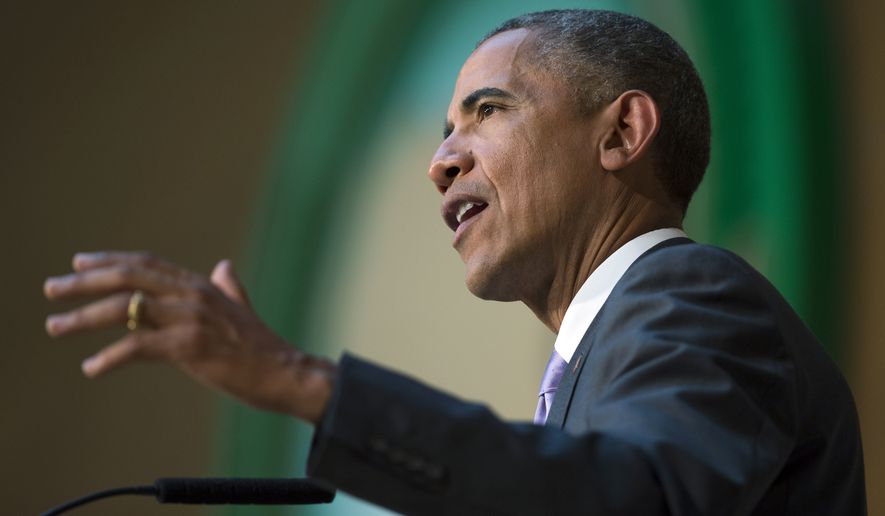President Obama argues that his policies will result in cleaner air and will mitigate the effects of climate change, but unintended consequences of the administration’s environmental agenda seem all but certain — possibly even including higher mortality rates across the country, according to at least one scholar.
Key pieces of Mr. Obama’s environmental plan, including proposals to increase ozone standards, limit carbon emissions from power plants and continue mandating more ethanol in U.S. gasoline supplies, will bring with them serious side effects in the coming months and years, critics and some analysts say.
Those effects could include higher electricity rates and the loss of jobs in the manufacturing and energy sectors. And by continuing to push the Renewable Fuel Standard (RFS) — which began during former President George W. Bush’s administration and requires that ethanol be blended into gasoline — despite serious questions about its effectiveness and viability, some analysts contend the administration is putting Americans’ health at risk.
“The Renewable Fuel Standard, because it is currently dominated by corn grain ethanol, is responsible for reduced air quality over much of the U.S., which leads to increased mortality,” Jason Hill, associate professor of bioproducts and biosystems engineering at the University of Minnesota, told a House subcommittee last week, adding that the blended gasoline is cleaner when burned but the production process releases harmful pollution.
The Renewable Fuels Association, which promotes the use of ethanol and other renewable fuels in gasoline, argues the practice will reduce pollution and save consumers money at the gas pump. Ethanol proponents in Congress also soundly rejected Mr. Hill’s claim during last week’s hearing.
But potential unintended consequences of the administration’s climate agenda go beyond concerns with the RFS.
SEE ALSO: Obama carbon rules ‘biggest, most important step’ ever to fight climate change
Data from the federal Energy Information Administration has shown that the EPA’s Clean Power Plan, the final version of which will be released Monday, will raise electricity rates for average Americans, at least in the short term. The proposal will limit carbon emissions from power plants, and the EPA has admitted that coal’s share of U.S. power generation will drop by about 25 percent if the plan is fully implemented.
The administration is expected to unveil stringent standards but may give states until 2022 to meet emissions targets rather than 2020, as originally planned, according to media reports.
There also are questions swirling around the EPA’s new ozone standards, due out in October. The proposal is expected to lower surface ozone standards from 75 parts per billion to 65 or 70 parts per billion, and critics fear the plan ultimately could be the most expensive regulation in U.S. history.
Costs for compliance with the rule could be as high as $10 billion a year, estimates show.
The Chamber of Commerce and other top business groups also warn that the ozone standards could delay key infrastructure projects, such as the D.C. metro system’s Purple Line expansion and lane widening on Interstate 270. Regions that fail to meet the EPA’s new ozone standards technically could lose out on federal highway and infrastructure funding, though the administration vehemently denies that will happen.
Denials aside, critics say the cumulative effect of Mr. Obama’s climate policies could be devastating.
SEE ALSO: Hillary Clinton, Democratic front-runner, backs Obama’s plan on power plant emissions
Average Americans may only truly learn how severe the consequences will be once it is too late, according to Dan Kish, senior vice president for policy at the conservative Institute for Energy Research.
“In many cases, they won’t find out until they’re ramped up. The only law that ever seems to constantly get passed in Washington is the law of unintended consequences,” Mr. Kish said. “It isn’t until all of these things go into place that you can watch what’s going to happen. You can’t put layer on layer on layer. Eventually, the camel’s back breaks.”
In laying out his climate proposals, Mr. Obama has said the U.S. must be a global leader on the issue and argues serious crackdowns on greenhouse gas emissions are necessary both to improve public health and bolster national security.
The president has cast climate change as perhaps the greatest national security threat facing the U.S. today, and the Pentagon last week released a new report saying extreme weather and other effects of global warming threaten world stability.
“Global climate change will have wide-ranging implications for U.S. national security interests over the foreseeable future because it will aggravate existing problems — such as poverty, social tensions, environmental degradation, ineffectual leadership, and weak political situations — that threaten domestic stability in a number of countries,” the Defense Department said.
But the pushback on Mr. Obama’s climate agenda is growing stronger by the day.
On ozone, the National Association of Manufacturers this week launched a multimillion-dollar ad campaign opposing the new standards. The group argues that jobs will be lost and the economy hamstrung by the proposal.
“Unfortunately, the new proposed ozone standard is so over-the-top, even places with no industrial activity for miles around will be considered noncompliant,” the association’s president and CEO, Jay Timmons, said in a statement.
On electricity prices, recent federal data show that the Clean Power Plan will drive up costs in many parts of the country, though the research does say prices eventually will stabilize. One recent report from the Energy Information Administration said average electricity prices could rise by as much as 7 percent as a result of the plan. The regulations also are already being blamed for the closure or conversion of coal-fired power plants across the country.
For those reasons, critics have vowed to file new lawsuits challenging the Clean Power Plan. Some Republican governors, such as Indiana’s Mike Pence, have said they’ll ignore the regulations entirely.
Still, the EPA denies that the plan will harm the economy, cost jobs or drive up energy and electricity prices. On the ozone regulations, the agency last month blasted the Chamber of Commerce and its partners for perpetuating the notion the federal government would cut off highway funding.
“If an area acts in good faith by developing and implementing an initial plan to attain the [ozone] standard, but does not attain by its attainment date, highway and transit funds will not be withheld,” the agency said in a statement.
Furthermore, the agency also downplays the looming electricity price hikes. EPA Administrator Gina McCarthy in June said that while the Clean Power Plan could raise prices in the short term, prices ultimately will drop as a result.
Beyond that, she said, the public health benefits of less pollution far outweigh any costs.
“Not all carbon reduction strategies actually cost money,” she said.
• Ben Wolfgang can be reached at bwolfgang@washingtontimes.com.




Please read our comment policy before commenting.